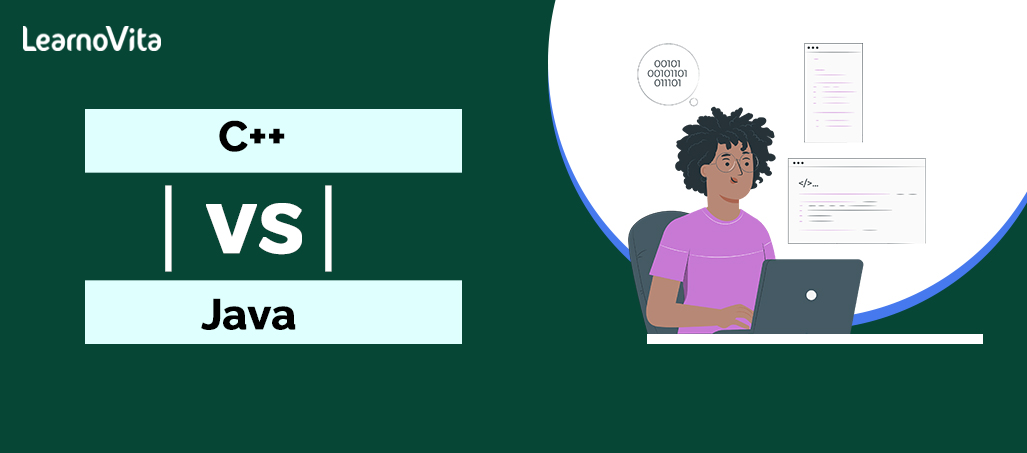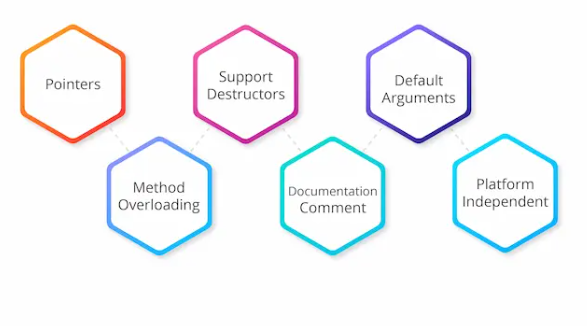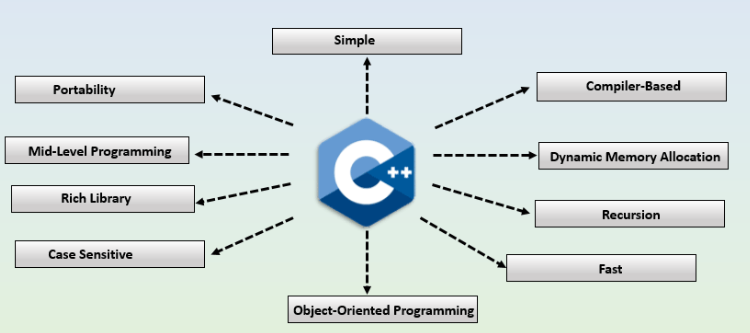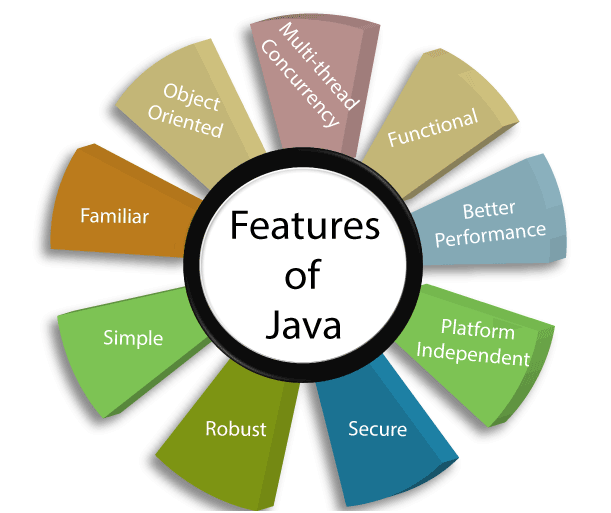
C++ vs Java | Difference You Should Know
Last updated on 27th Oct 2022, Artciles, Blog
- In this article you will learn:
- 1.Introduction
- 2.What exactly is C++?
- 3.What exactly is Java?
- 4.C++ vs Java
- 5.Additional Comparisons of Java and C++
- 6.C++ versus Java Salary
- 7.Benefits of C++ vs. Java
- 8.Characteristics of C++:
- 9.Features of Java
- 10.Conclusion
Introduction
Because they have so many features, C++ and Java have become two of the most used programming languages. Java has become the most popular language for making software in the IT industry, while C++ has become more popular because it is fast, efficient, and uses memory in a dynamic way. This thorough blog about C++ vs. Java will assist you in comparing the two languages and understanding their distinctions.
What exactly is C++?
The C++ programming language is based on the C programming language and has many of the same characteristics. C++ was built primarily for the creation of systems and applications. The first programming language to have ideas like classes and objects was C++. It can hold both low-level and high-level C features while also being an intermediate-level language.
What exactly is Java?
Java is made with a virtual machine, which lets developers keep the code’s security and make it very portable. Java is combined with a full library that provides abstraction support. This language is designed primarily for application development. Also, Java’s ability to be interpreted makes printing systems easier, which has helped the development of network computing.
C++ vs Java
After a brief introduction to Java and C++, let’s examine the differences between them.

- C++ code must be built for each platform on which it is used. Java, on the other hand, is portable, meaning it can run on any platform.
- C++ source code is compiled into an object code that, when executed, produces output, whereas Java source code is a platform-independent byte code.
- In C++, developers must use operators like “new” and “delete” to create and free up memory for the code. In Java, however, the system does this automatically.
- Java does not enable multiple inheritance, unlike C++. However, Java may achieve the same result as multiple inheritance via interfaces.
- C++ is an object-oriented and procedural programming language; hence, it does not adhere to certain root hierarchies, whereas Java is an entirely object-oriented language with a single root hierarchy.
Additional Comparisons of Java and C++
- C++ doesn’t have a root hierarchy because it is a hybrid language that can be used for both procedural and object-oriented programming. As a purely object-oriented programming language, Java has a single root hierarchy.
- There is no specific link between file names and class names in C++. This permits C++ to have several classes with arbitrary file names; the file names do not need to correspond to the class names. In contrast, Java enforces a close link between the two, so the name of the class containing the source code must match the file name.
- C++ is superior to Java for system-level programming because it permits direct library calls, whereas Java does not. In Java, however, developers can use Java Native Access or Java Native Interface to call the libraries.
- C++ is distinguished from other languages by its object-oriented language and procedural language-based features. On the other hand, Java’s distinctive characteristic is its automatic garbage collection.
C++ versus Java Salary
Benefits of C++ vs. Java:
Advantages of C++
- Depression
- Medium planning language
- Attend to the object
- Multi-paradigm planning language
- Memory Administration
Advantages of Java
Java is a target language and a general-purpose programming language that assists in the development of applications and programs in any field. There are numerous advantages to Java that allow you to continue using it. Let’s discuss the advantages of using the Java programming language.
- Java is Simple
- Java is an object-oriented programming (OOP) language.
- Java is a protected language.
- Java is low-cost
Characteristics of C++:
1. Object-Oriented Programming (OOP)
C++, as opposed to the process language C, is an object-oriented programming language (OOP). OOP aids in the planning and maintenance of the system. It improves code clarity, code readability, and troubleshooting, and makes conversions simple to implement without extensive redesign. In addition, OOP employs materials to generate real-world problems based on five sound assumptions.

- Data Release
- Data Entry
- Hiding Data
- Ifa
- Polymorphism
2. Independent Machine
The capacity to transfer commands from one workplace to another is referred to as “automation” (or “portability”) in this context. C++ implements the WORA policy (Write Once, Run Anywhere). For instance, if you build a program on Microsoft Windows and are forced to move to Linux, the original program code will continue to function as intended. However, C++ does not exist in a vacuum. This means that the compiler will make an OS-based.exe file that works with more than one operating system.
3. Easy
C++ is user-friendly. It provides a systematic and exhaustive syntax paradigm similar to C. In fact, C++ is commonly referred to as “C in categories.” Any project’s development can be restructured into logical parts and components using the C++ programming language. In addition, it provides a vast selection of built-in library functions and data types.
4. Language for Intermediate Planning
As a medium-level language, it supports both low-level (machine-level) and high-level language characteristics. It is a private language that is closely related to English, which is an easy-to-understand human language.
5. Using the Compiler
C++ is intended to be an integrated programming language. Consequently, it is typically transformed into machine language that the program can immediately comprehend. Based on the interpreter, the resulting system is significantly more efficient and faster than Python or Java.
Distributed Capable Memory
Memory in C++ can be partitioned into stack and bulk sections. “Stack” refers to the memory allocated to variables declared within a function. In contrast, “bulk” refers to unused, randomly assignable memory. For example, if you don’t know how much memory you need to store information on defined variables, the size of the memory can be automatically calculated while the program is running. This is achieved by utilizing a specific operator known as the new operator, which returns the address of the allocated space. If necessary, memory can be partitioned using the delete operator.
Features of Java
Here are the program’s advanced features for further information:
1.Simple and Traditional
It eliminates complexity since it does not employ the following complicated and complex aspects of other languages, such as C and C ++:

- Clear Identifiers Storage classes as a concept
- The use of preprocessors and header files
- Multiple Inheritance Operator Upload
- Invoked Statements
- In addition to the elimination of these unclear and ambiguous concepts, automatic garbage collection is provided, where it is unnecessary to remove elements that are not expressly addressed.
2. Compilation and translation
Computer languages can typically be compiled or translated. Java combines the potential of integrated languages with variations in translated languages. The Java compiler (javac) integrates Java source code into bytecode. The Java Virtual Machine (JVM) uses this portable and usable format for most application bytecode.
3. Independent Foundation
One of Java’s most important features is that it works on any platform. This makes it portable, which is its biggest strength. Local autonomy signifies that a system incorporated into one machine can be implemented without modification on any machine in the world. Using the BYTE code idea, Java achieves domain independence. Java compilers never turn source code into machine code like a C / C ++ compiler. Instead, it transforms the source code into a core code known as “byte code,” which is then translated into machine-based form by another software layer known as JVM (Java Virtual Machine).
4. It is transportable
- The Standard Edition (SE) version of Java is “portable.” Actually, the effect derives from the neutrality of the structures.
- C/C++ source code may function slightly differently on different hardware, but Java simplifies the process. Java bytecode can be used on any machine that has a JVM that is compatible and can convert bytecode to match the machine’s needs.
- The size of the old data types in Java has nothing to do with whether they are C or C++. Because of these features, Java applications can run on many different platforms, such as Windows, Unix, Solaris, and Mac.
- Also, Java applications won’t need to be changed if the operating systems, processors, or system resources are updated or changed.
5. Architectural Neutral
- This term means that a program made for one domain or operating system can run on any other OS without having to be reinstalled.
- In other words, it is based on the “Write-then-run-anywhere” (WORA) or “Write-run-anywhere” (WRRA) methodology (WUBE).
- Byte-code doesn’t depend on the format of any particular machine, and the Java Virtual Machine (JVM) can easily turn byte-code into code that works on that machine.
- This capability is extremely handy when developing applets or downloading applications online.
- Also, these apps have to work on a variety of machines, so this seems to be a very important feature in this case.
6. Concentrate on the object
- Next in this post about Java features, we will explore the OOP feature. Java highly encourages object-oriented programming due to its reputation as a pure object language.
- Encapsulation, abstraction, and asset management are important. Focused editing concepts are supported by Java.
- In Java, nearly everything is a thing. All applications and data are contained in classes and objects. Model for “objects” as opposed to ‘processes’ in Java. Java includes an extensive collection of classes arranged by packages.
- We cannot, for instance, upgrade Java apps without a classroom. This demonstrates that Java properly adheres to the encapsulation guideline.
7. It is sturdy
- Java is reliable because it can deal with temporary failures, it supports automatic garbage collection and separate management, and it doesn’t use explicit identifiers.
- Java has a solid memory management system. It facilitates debugging by comparing the code between integration and operation times.
- Java is a garbage-collection language, which means that the JVM automatically gets rid of memory barriers, and editors don’t have to delete memory by hand like they do in C and C++.
- Java also includes a distinct management model that discovers and removes runtime faults.
- In Java, any operational time error detected by the JVM is never sent directly to the underlying system, but instead immediately disconnects the system to prevent subsystem damage.
8. safeguard yourself
- Because there is a chance of bad behavior and viruses, security is a very important issue for all programming languages. Java lets accessibility modifiers check how memory is accessed and make sure the applet doesn’t have viruses.
- Because editors can’t make explicit references in Java, it is a safer language than C/C++. In Java, we cannot access certain variables if they have not been properly initialized.
- Apps run in a “virtual sandbox,” which is a feature that lets users run their apps without changing the system.
- Contains a bytecode authentication checker for unlawful code snippets that violate access.
Conclusion of C++ and Java
C++ has the same benefits as C plus more capabilities. C++ has a gentle learning curve, making it accessible to novice editors. Larger apps shouldn’t be labeled as C++, but small to medium-sized apps can be labeled as C++ to make them faster and easier to scale.
Java is a safe programming language that can be used to make a lot of different kinds of programs. adds a parametric polymorphism machine to Java so that common abbreviations can be defined and used. The paper provides a comprehensive framework for expanded language.
Are you looking training with Right Jobs?
Contact Us- C++ Constructors Tutorial: Types and Copy Constructors
- C++ Reference Tutorial | A Comprehensive Guide for Beginners
- C# Vs Java Tutorial | Overview and Key Difference
- What is Abstraction in Java | Implementations of Abstraction in Java | A Definitive Guide with Best Practices
- Kotlin vs Java | Know Their Differences and Which Should You Learn?
Related Articles
Popular Courses
- Hadoop Developer Training
11025 Learners - Apache Spark With Scala Training
12022 Learners - Apache Storm Training
11141 Learners
- What is Dimension Reduction? | Know the techniques
- Difference between Data Lake vs Data Warehouse: A Complete Guide For Beginners with Best Practices
- What is Dimension Reduction? | Know the techniques
- What does the Yield keyword do and How to use Yield in python ? [ OverView ]
- Agile Sprint Planning | Everything You Need to Know
